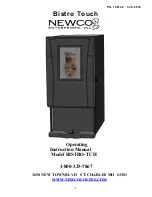
PCI-DAS64/M1/16 User's Guide Functional
Description
Table 4-1. Analog input range and resolution configurations
lists the input ranges and resolutions for the available input configurations and gains.
Bipolar Unipolar
Range
Resolution
Range
Resolution
±5 V
153
µ
V
0 to 5 V
76.3
µ
V
±2.5 V
76.3
µ
V
0 to 2.5 V
38.1
µ
V
±1.25 V
38.1
µ
V
0 to 1.25 V
19.1
µ
V
±0.625 V
19.1
µ
V
Burst mode
Channel-to-channel skew is the result of multiplexing the A/D inputs. It is defined as the time between
consecutive samples. Burst mode minimizes channel-to-channel skew by clocking the A/D at a high rate
between successive samples within a scan, then waiting a specified time before starting a new scan. The PCI-
DAS64/M1/16 provides burst mode with a 1
µ
s minimum sample skew/delay.
Analog output
The PCI-DAS64/M1/16 board provides two high-speed, ±5V 16-bit analog outputs. The outputs are updated via
on-board 16 K FIFO buffer and provide a 100 kHz (max) update rate. Repetitive D/A-based waveforms can be
stored in on-board memory and generated without requiring ongoing PCI bus transfers. The outputs provide
rated accuracy to ±15 mA, are short-circuit-protected (25 mA limit) and are cleared to 0 volts on power-up or
reset. The board supports simultaneous full speed operation of both the A/D and D/A.
Digital I/O
The PCI-DAS64/M1/16 provides 32 bits of digital I/O. An 82C55 chip provides 24 bits of CMOS compatible
I/O at the board’s 40-pin auxiliary digital connector. Four LSTTL-compatible digital inputs and four outputs are
provided on the main 100-pin connector. On power up or reset, all I/O ports default to the input state (high
impedance).
Counter/timer I/O
The PCI-DAS64/M1/16 provides one 16-bit down counter (1/3 of an 82C54). Clock, gate and output
connections are available at the 100-pin user I/O connector.
4-2
Содержание PCI-DAS64/M1/16
Страница 1: ......
















































